Everyone knows the story of Polyphemus, the giant one-eyed Cyclops who imprisoned Odysseus and his crew in a cave, then ate six of them before Odysseus devised a cunning plan to escape. (If not, you must read Homer’s ‘The Odyssey’.) But did you know that Polyphemus’ cave, supposedly on Sicily, is actually in the hills above and east of Sougia, along the coast from Paleohora?
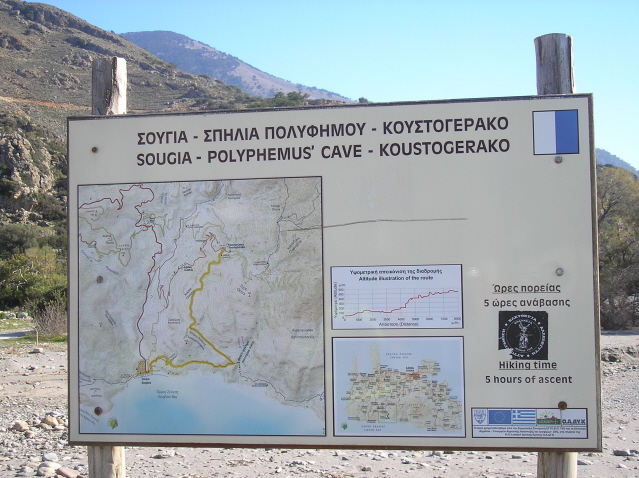
Directions to the cave with the one-eyed, man-eating monster (!)
The route to the cave , and on to Koustoyerako, is relatively recent, waymarked (in blue and white) presumably by the Chania Mountain Club (EOS Chania) in the late summer of 2009. The walk to the cave and back from Sougia takes around six hours, and will fit in with the ferry from Paleohora, whilst the continuation to Koustoyerako, returning via Livadas, is a full and strenuous day.
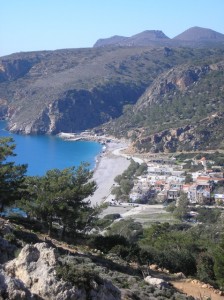
Looking back to Sougia
The E4 trail runs for over 8000 km (from Gibraltar) to Kato Zakros in SW Crete, and there’s a good chance that the hardest navigation in its entire length is finding your way out of Sougia. From the information board at the far eastern end of the seafront, walk inland on the road, left of the riverbed for 200m. Cross the river diagonally, and head for the single-story house beyond its far side. Keep left of the house fencing, to pick up a waymarked (red) trail uphill, which meets a bulldozed track. Stay on the track, passing through a wire gate and animal feeding troughs, until it ends at a small plateau and grazing area. Enjoy the ‘birds’ eye’ view down to Sougia, and along the coast towards Profitis Ilias, then head slightly downhill on the path, now waymarked in black/yellow with occasional cairns and E4 poles.
The next hour or so, along a footpath as scenic as any in Crete, is an olfactory and visual delight, walking under fragrant Aleppo pine trees and brushing through aromatic thyme bushes, with Homer’s “wine dark sea” below.
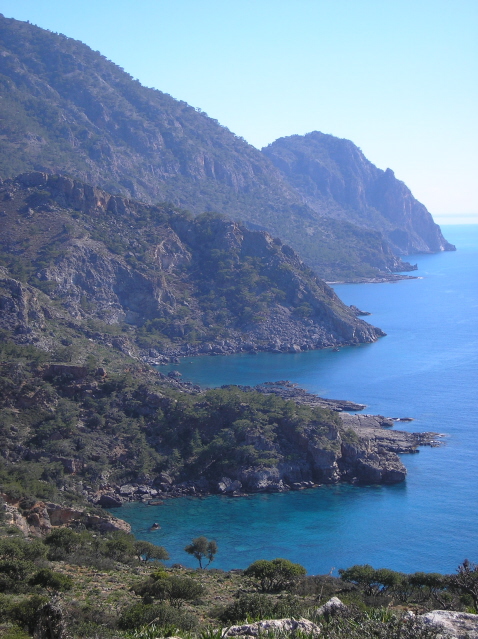
Eventually the path swings inland, heading up towards a col/saddle. The E4 continues east, to Profitis Ilias church and on to Agia Roumeli, as described in our book (see below), but the route to Polyphemus’ cave branches off sharply to the left, clearly indicated by blue/white waymarking.
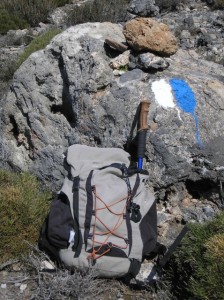
Look for the markers
Follow the path, such as it is, climbing by a short section of ‘kalderimi’ to reach a plateau, close to a memorial. The cross marks where a young Cretan, only 21, “was murdered here by the Germans.” A sad place indeed.
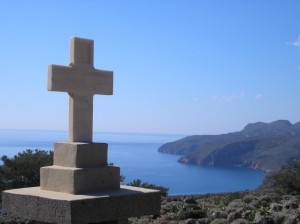
Pause for a moment to reflect.
Onwards and upwards, over rough ground and many boulders, to reach the cave, signposted and slightly off left from the ascent route.
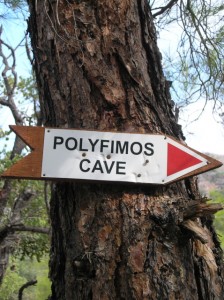
Initial disappointment at the cave’s small entrance is alleviated once you explore inside – it’s immense! You remembered to bring a torch, didn’t you? Even without, you can see many impressive limestone rock formations, and ample evidence of the flocks of sheep and herds of goats which the Cyclops once kept here …. maybe.
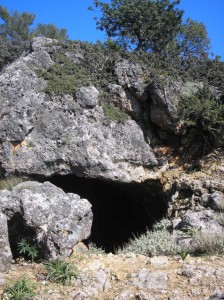
Small entrance belies the cavern within
At a height of 300m, the grassy terrace outside the cave is a perfect picnic site, with particularly good views over to Gavdos, claimed to be ‘Calypso’s Isle’ where the nymph held Odysseus captive for seven years.
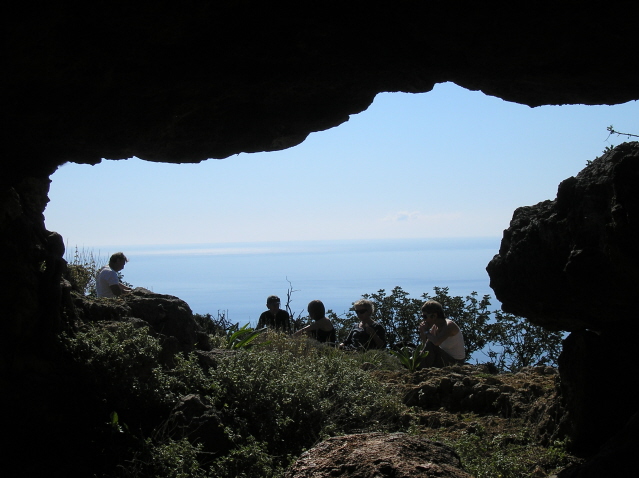
Return to Sougia by the same route in time for a swim and the late afternoon ferry back to Paleohora.
Alternatively, continue on to Koustoyerako. The path traverses into and out of a shallow gully, but then is intermittent or non-existent. Follow the waymarking carefully, via three isolated pine trees, and a final ascent to meet a track to the right (north) of radio/’phone masts. Turn right along the track for 3 km into Koustoyerako, pausing at the first bend to look (with care!) into an enormous crater.
More about Koustoyerako another time. From here it’s around two hours back to Sougia ; the top bends of the main road can be avoided by an old trail to Livadas, which begins left of the village cafenion. Below Livadas, leave the road for a track heading south, climbing slightly, then winding down into Sougia, and passing en route – of all things – a herd of fallow deer, possibly the only one on Crete.
‘More Walks from Paleohora’ available from ‘To Delfini’ bookshop, together with a few remaining copies of ‘Ten Walks from Paleohora’.


Recent Comments